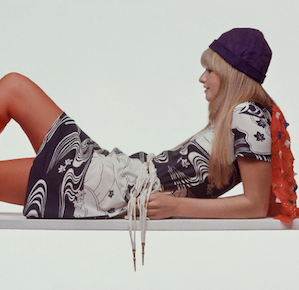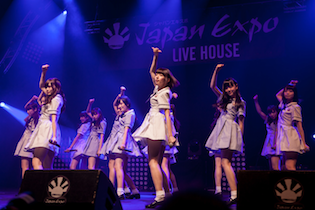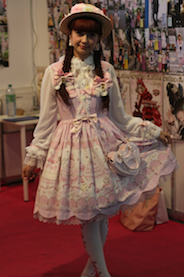Kawaii Culture and Fashion in the West, a Brief History
When you think about ‘kawaii style’ Europe doesn’t exactly come to mind. But for a long time people have worn and incorporated clothing fitting this aesthetic into their own style. The question is, how did ‘kawaii’ make its way from Japan to here and what influence does it have nowadays?
Around the beginning of the 20th century Japanese culture slowly infiltrated the elite class of France. Western people with kimonos were portrayed in art pieces and Japanese fashion slowly started to make its way into the French (and European) culture.
But it wasn’t until 1970’s that really started to make its way into Europe. Between the 70’s and the 80’s, avant-garde Japanese designers such as Hanae Mori were able to showcase their designs in high-fashion shows in Paris. Various of these designs showcased kawaii fashion in all its glory. However this also meant that it kind of had an elite status and thus wasn’t being seen nor worn by the general Western public. Other types of Japanese popular culture (of that time) on the other hand, made its way to Europe. Again, France was one of the key players but this time Italy was also greatly involved in this phenomenon. These two countries brought in Japanese comics, manga and commercial animation, anime and eventually became a European hub for Japanese culture in which the youth took interest.

So much that in 1999, France started hosting ‘The Japan expo’, an event near Paris. According to Marcus Aaron in his paper ‘Cuteness in Japan’, this attracted not only the French but in general the European youth, mostly girls. This event made cosplay, dressing up as the various, (frequently cutesy) characters you see in manga and anime possible, and popularized it with both children and teenagers. Later Japanese fashion, which with these events was mostly “kawaii fashion”, also made its way into these events and even now according to Aaron “this event is now focusing on aspects of Japanese culture and pop culture and “kawaii” is one of the central concepts.” According to him “this was the first time that Japanese culture is enthusiastically attracting attention among ordinary people in foreign countries.” This popularization of manga, anime, cosplay and fashion boosted by events held by European countries brought with it the popularization of ‘cute’ characters such as Hello Kitty, who became a prominent staple of cute clothing during the 90’s and 00’s period in the West.

This made it possible for ‘new’ Japanese fashion trends such as kawaii fashion to make its way into these events and even now according to Aaron “this event is now focusing on aspects of Japanese culture and pop culture and “kawaii” is one of the central concepts.” According to him “this was the first time that Japanese culture is enthusiastically attracting attention among ordinary people in foreign countries.”With these characters with cute expressions and bright colors gaining a lot of popularity in the general public, this meant that not only the elite fashion world was now able to adapt Japanese fashion into their life but the everyday person as well.
However it is not solely due to manga and anime events that Japanese fashion was able to make its way to the West. Music also started to become a big factor for both Japanese fashion and culture, such as Avril Lavigne’s song ‘Hello Kitty’ which gained a lot of popularity at the time. Japanese music is fairly popular in the west as well nowadays, the Japan Expo also hosts various groups to perform at its event.
Kyoko Koma says in the paper ‘Reception of Japanese and Korean Popular Culture in Europe’ that “the origin of information for Kawaii fashion nowadays is principally the Internet, a medium accessible for everybody.” ‘Cute’ designs with bright and pastel colors are taking over the world. Furthermore with drama’s, movies, manga, anime and music being much more accessible than before the mentality of wanting to dress like certain actors/actresses, idols and other famous people grew more and more, which also meant the expansion of kawaii fashion in the West. She also mentions that “even if wearers of kawaii do not understand Japanese, they try to imitate the style presented in these media.”

However the most important influential media today are social media platforms. This globalisation of social media is becoming one of the biggest factors regarding the exponential growth of the popularity of Japanese culture. With instagram being one of the most influential social media platforms fashion wise it also brought upon a flood of kawaii fashion/aesthetic catered profiles. When you type in certain hashtags such as #kawaii, both the romanized and hiragana-written version showcase mostly Western people making the fashion trend their own. We don’t know what the future will bring but the kawaii market is growing exponentially and most likely will continue to do so.
Sources
- Marcus, Aaron, Masaaki Kurosu, Xiaojuan Ma, and Ayako Hashizume. "Cuteness in Japan." Cuteness Engineering Springer Series on Cultural Computing, 2017, 33-61. doi:10.1007/978-3-319-61961-3_2.
- Pellitteri, Marco. "Kawaii Aesthetics from Japan to Europe: Theory of the Japanese “Cute” and Transcultural Adoption of Its Styles in Italian and French Comics Production and Commodified Culture Goods." Arts 7, no. 3 (2018): 24. doi:10.3390/arts7030024.
- Kyoko Koma. "Kawaii as Represented in Scientific Research: The Possibilities of Kawaii Cultural Studies.", 2013
- Onohara, Noriko. "Japan as Fashion: Contemporary Reflections on Being Fashionable." Acta Orientalia Vilnensia 12, no. 1 (2011): 29-41. doi:10.15388/aov.2011.0.1095.
- Sung Eun Choi, Takashi Kitamura, Kyoko Koma, SangGum Li, Jinseok Seo, Martynas Šiaučiūnas-Kačinskas, Aurelijus Zykas. “Reception of Japanese and Korean Popular Culture in Europe” Acceptance of Japanese and Korean Popular Culture in Europe, (2010-2011)